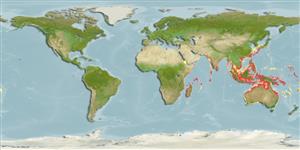Common names from other countries
>
Eupercaria/misc (Various families in series Eupercaria) >
Labridae (Wrasses) > Bodianinae
Etymology: Choerodon: Greek, choiros = a pig + odous = teeth (Ref. 45335); referrring to the prominent anterior canines of the species in this genus (Ref. 116605).
More on author: Valenciennes.
Environment: milieu / climate zone / depth range / distribution range
Οικολογία
Θαλασσινό(ά) Υφαλόφιλο(α); εύρος βάθους 10 - 60 m (Ref. 9710), usually 10 - 20 m (Ref. 2334). Tropical
Indo-West Pacific: Ryukyu Islands south to Australia and Indonesia. Reported from Mauritius (Ref. 5503).
Length at first maturity / Μέγεθος / Βάρος / Age
Maturity: Lm ?, range 24 - ? cm
Max length : 100.0 cm TL αρσενικό/απροσδιόριστο; (Ref. 2272); μεγ. δημοσιευμένο βάρος: 15.5 kg (Ref. 2334)
Ραχιαίες άκανθες (συνολικά) : 13; Μαλακές ραχιαίες ακτίνες (συνολικά) : 7; Εδρικές άκανθες: 3; Μαλακές εδρικές ακτίνες: 10. Large adults appear blue underwater and usually have a small black spot at the dorsal fin base. Juveniles have a large white saddle spot following the black spot (Ref. 48636). A moderately small but prominent dark spot present on body at base of last dorsal-fin spine (spot not extending onto fin membrane). Body scales each with a blue centre in life forming horizontal rows of spots on side. Second prominent anterior canine in lower jaw distinctly shorter than first in adults, directed mostly dorsally and slightly anteriorly. 3 to 5 scales on subopercle. (Ref 9823)
Inhabit flat sandy or weedy areas near lagoon and seaward reefs (Ref. 9710). Solitary. Feed mainly on hard-shelled prey including crustaceans, mollusks and sea urchins. Marketed mostly fresh. In Hong Kong live fish markets (Ref. 27253).
Oviparous, distinct pairing during breeding (Ref. 205).
Randall, J.E., G.R. Allen and R.C. Steene, 1990. Fishes of the Great Barrier Reef and Coral Sea. University of Hawaii Press, Honolulu, Hawaii. 506 p. (Ref. 2334)
IUCN Red List Status (Ref. 130435)
CITES (Ref. 128078)
Not Evaluated
Threat to humans
Harmless
Human uses
αλιεία: Εμπορικό(ά); Υδατοκαλλιέργειες: Εμπορικό(ά); αλιεία αναψυχής: ναί; Ενυδρείο: Εμπορικό(ά)
Εργαλεία
Special reports
Download XML
Διαδικτυακές πηγές
Estimates based on models
Preferred temperature (Ref.
115969): 24.5 - 29, mean 27.9 (based on 478 cells).
Phylogenetic diversity index (Ref.
82804): PD
50 = 0.5000 [Uniqueness, from 0.5 = low to 2.0 = high].
Bayesian length-weight: a=0.01318 (0.00582 - 0.02984), b=3.05 (2.86 - 3.24), in cm Total Length, based on LWR estimates for this (Sub)family-body shape (Ref.
93245).
Τροφικό Επίπεδο (Ref.
69278): 3.4 ±0.41 se; based on food items.
Ελαστικότητα (Ref.
120179): Μεσαίο(α), ελάχιστος χρόνος για διπλασιασμό πληθυσμού 1,4 - 4,4 έτη (Preliminary K or Fecundity.).
Fishing Vulnerability (Ref.
59153): Moderate vulnerability (39 of 100).
